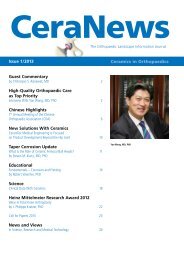BIOLOX - Nanocomposite for Arthoplasty
The Fourth Generation of Ceramics
The Fourth Generation of Ceramics
Create successful ePaper yourself
Turn your PDF publications into a flip-book with our unique Google optimized e-Paper software.
Tribology and Arthroplasty<br />
Competence in Ceramics<br />
Material Properties<br />
The Strengths of <strong>BIOLOX</strong> ® delta<br />
Molecular Bonding<br />
6<br />
Loose Metal Structure<br />
The molecular structures of metal alloys<br />
and ceramic materials are fundamentally<br />
different. In the case of a metal bond,<br />
the electrons orbit the atomic nuclei in<br />
an irregular manner and with relatively<br />
low bonding strength. As a result of this,<br />
metal ions continuously exit this molecular<br />
structure and, in the case of implants, are<br />
absorbed by the surrounding tissues. This<br />
occurrence can result in many different<br />
chemical reactions.<br />
Stable Ceramic Structure<br />
In ceramic molecules, the electrons follow<br />
exactly specified paths or electron orbitals.<br />
The electrons’ bonding strength is very<br />
high, making the molecules themselves<br />
extremely stable. This prevents ion <strong>for</strong>mation<br />
and chemical reactions within the<br />
body.<br />
Metal bonding (left):<br />
irregular electron orbitals<br />
permit the <strong>for</strong>mation<br />
of ions.<br />
Ceramic bonding<br />
(right): tight electron<br />
orbitals rule out ion<br />
<strong>for</strong>mation and chemical<br />
reactions.<br />
Atomic nucleus<br />
Electron












